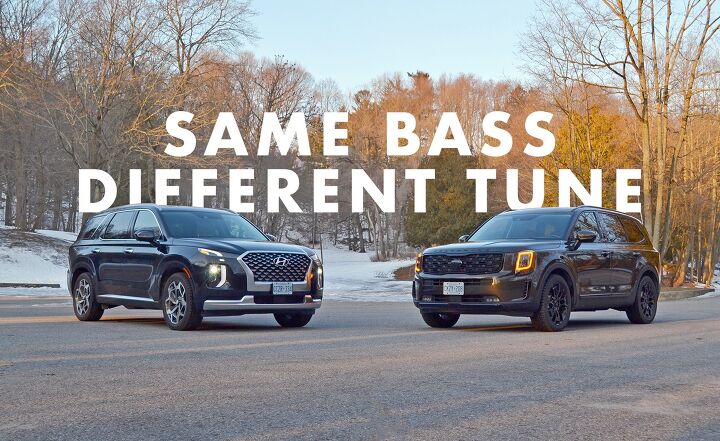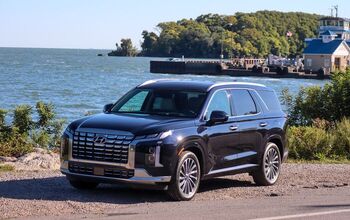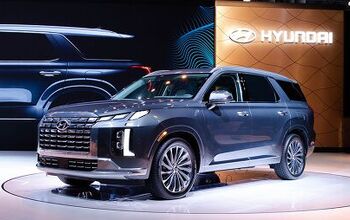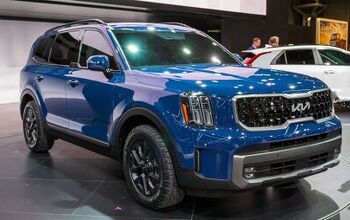Hyundai Palisade Vs Kia Telluride Comparison

Never judge a book by its cover—or a car by its brochure—seems like sound advice.
But what if the two cars in question share the same platform and powertrain? Then are they fundamentally the same even if they belong to different brands? Well … not quite.
Musicians new and old are famous for using similar bass lines in songs to strike a sense of familiarity with the audience, a trend that has really taken off in the digital age of shrinking attention spans and instant gratification. Despite the different riffs, vocals, and even feel of songs, the underlying structure is quite often the same. This brings us to these two, the 2021 Hyundai Palisade and Kia Telluride, both in their new top trims, the Calligraphy (Ultimate Calligraphy in Canada) and Nightsky Edition (Nightfall), to be precise.
Despite their irrefutable similarities, there are some key differences between these two mid-size three-row crossovers. But the question still remains: which one is better?
Styling
Palisade: Usually we reserve this category for the end, but the styling is one of the primary differentiating factors between these crossovers, so here we are. Starting with the Palisade, in profile, it looks like a scaled-down version of the typical American three-box SUV. Think Escalade, but designed in South Korea. The face is a bit more European and, in your author’s personal opinion, the best face on any Hyundai yet. I’m sure I’m misquoting here but the waterfall-imitating, bright white DRLs flow flawlessly. The bodywork doesn’t interrupt the flow of the DRLs either.
Get a Quote on a New Kia Telluride or Hyundai PalisadeThe DRLs combined with the massive grille, a muscular hood and a traditional three-box design give the Palisade an elegant and urban look. The 20-inch alloys certainly add to the aesthetic as well. But the overall elegance does have a couple of caveats: for starters, the chrome seems a bit overdone. Secondly, there is a misalignment in the panels at the C-pillar which take away from the overall quality of design. The worst part; you can’t unsee it.
Telluride: You would expect the two three-row trucklets here to share body panels and exterior bits; they both share the same DNA afterall. But you’d be wrong. Unlike GM where generally only the face and features differ between models, the Telluride is completely different compared to the Palisade. It is its own crossover and even the way the three-box design flows is different. Where the Palisade has a clear partition for the third box, the Telluride goes for a more unified design akin to the BMW X7.
The Telluride is also the more rugged-looking of the two. And the things that are bling on the Palisade are black on the Telluride. The headlamps get a smoky tint, andso do the vertically stacked tail lamps. The lettering on the hood is black too, and so is the badge. Stealth seems to be the theme of the Nightfall package and when you combine the aforementioned elements with black alloys and a Dark Moss exterior paint you get a crossover that no one can ignore. Also, Kia’s decision to go for orange DRLs—a trait shared with the K5 sedan—deserves a standing ovation in our books for they are the coolest set of DRLs out there.
SEE ALSO: 2021 Kia K5 GT-Line AWD Review: A Covetable Mainstream Sedan?Bottom Line: Despite being a subjective matter our pick of the lot would be the Telluride. I am quite conflicted as to which looks better, while the orange DRLs are the clear winner, the overall design of the Palisade makes the decision quite difficult. This one is a tie.
Interior and Cargo Space
Palisade: Despite both looking like large sizeable SUVs, they are actually not that large from the outside. I judge how big an SUV is based on how much of it hangs out of the driveway. I was rather surprised that both cars actually fit in the driveway with room to spare. Kudos to the design team considering their cavernous cabins. This is no ordinary Palisade so it is imperative that I refer to it as the Calligraphy as that trim makes an immense difference in how the cabin looks and feels.
Our tester was the Canadian spec Ultimate Calligraphy with a cream-and-wood interior, and opening the door treats to a sight to behold. There is a lot of hide and tree in here and all of it is very tastefully done. The door panel features brushed aluminium finishes along with wood on the shoulder and quilted leather on the door panels. The 10.25-inch infotainment and instrument cluster flow flawlessly into each other. Plus, the redundant controls for the touchscreen are the only ones on the clean and impeccable leather dash. Everything else, including the tri-zone climate control, drive mode selector are all part of the slightly raised center console.
The seats employ plenty of leather too, but the party piece has to be the felt headliner. Coupled with the forest and cow flock inside the cabin, it lends a richness to the cabin reserved for cars that are double in price and at least two segments above. If you’re looking for affordable luxury, this is it!
And there’s no dearth of space either. The Palisade offers 40.7 inches (1,034 mm) of headroom in the front and 40.1 inches (1,018 mm) in the second row. The moonroof takes away about an inch (25 mm) of headroom but unless you’re over six and a half feet tall, you will not notice. Also, it is worth mentioning that unlike most other SUVs, the Palisade comes with a twin moonroof setup rather than a single large panoramic one. And I have to say, it’s pretty cool.
SEE ALSO: 2020 Cadillac XT6 ReviewThe Palisade’s biggest draw however is the legroom it offers. The front and middle rows offer 44.1 and 42.4 inches (1,077 mm) of legroom while the third row offers 31.4 inches (797 mm) of leg space. To put things into perspective, legroom in the Cadillac XT6, a larger and much more expensive vehicle is about two inches less in all three rows. Then there is the standard cargo space of 18 cu-ft (509 liters) with all rows up. It expands to 45.8 (1,297 liters) and 86.4 cu-ft (2,446 liters) as you fold the third and second rows via one-touch buttons behind the third row.
Telluride: In terms of space, the headroom in the Telluride is slightly less owing to the panoramic moonroof, but otherwise the interior dimensions are identical to that of the Palisade. But that’s where the similarities end. The Telluride goes for an all-black leather theme. According to my colleague Kyle, “it feels remarkably premium in this segment—at least until you step into the Hyundai.”.
Though the cabin is tastefully done, the instrument cluster and infotainment system stacked as different units disrupt the design flow. The leather seats, though comfortable lack the opulence of the Palisade. The matte wood finish looks great though. In addition, Kyle points out that the “big swathes of hard plastic on rear doors is a bit of a downer,” and I agree that it diminishes the overall premium feel of the cabin.
While the third row is significantly smaller than the front two, it is far from uncomfortable. With 31.4 inches of legroom, regular and above average-sized adults can fit in the back. Plus, a ride lasting a couple of hours in the third row should be bearable. It’s also worth noting that legroom in the third row (in both) along with ingress and egress is superior compared to the Toyota Highlander and Mazda CX-9.
Bottom Line: While both the Palisade and the Telluride offer almost identical interior dimensions, the feel of their cabins are completely different. The Kia offers a premium but more conventional looking cabin. There is generous use of leather and wood but also plastic, which takes away from the overall premium feel. The Palisade on the other hand leaves no stone unturned to provide the most opulent experience possible to its occupants. A clean dash design and swathes of cream leather add to its character. That makes it a clear winner in this category.
Tech and Features
Palisade: Before the Palisade driver sits an all-digital instrument panel, which is only a notch or two below the brilliant 3D display found on Genesis cars. While it may lack the depth of the 3D display, the 12.3-inch cluster doesn’t leave you wanting more. One especially nifty feature is the blind spot camera that displays the feed in the dials depending on which indicator is on. While some might find this feature gimmicky and counter-intuitive, one cannot deny its usefulness. Yes, looking down isn’t natural while driving but it will give you a good idea of where the curb is while driving in the city and you wouldn’t want to scrub those striking 20-inch wheels.
SEE ALSO: Toyota Camry AWD vs Kia K5 AWD ComparisonThen there is the similarly sized touchscreen infotainment that is intuitive and easy to use. It is infinitely customizable but to be honest most would be using Apple CarPlay and Android Auto which is fine. But it is useful to know that the native system is user-friendly, except for the in-built navigation. The controls for the navigation are confusing and touching the screen tends to drop a pin for no good reason. Overall, it’s far less intuitive than Google Maps. Also, though there are numerous USB charging ports littered all around the cabin, the lack of USB-C port is the most glaring omission.
The head-up display on the Palisade is large and well laid out. In fact, the native navigation directions work better on the HUD than they do on the infotainment screen. But in my personal opinion, the Harman Kardon sound system is the cabin’s pièce de résistance. The sound emanating from the 12-speaker system is crisp and just the right amount of heavy. Metal listeners might feel the mid is a bit off but every other genre sounds great.
Telluride: Unlike the Palisade, the Telluride makes do with analog clusters flanking an LCD screen. A striking contrast compared to its half-brother, the cluster seems more dated due to the knurled surrounds. The HUD though, just like the Hyundai, is impeccable.
The Kia features curb-spotting blind spot cameras on either side as well but its feed comes up on the instrument cluster LCD. There are USB chargers in every row but just like the Palisade, there is no USB-C here either. And though it features the same HK sound system, the Hyundai’s cabin sounds marginally better thanks to two extra speakers.
Just like the Palisade, the Kia too gets the intuitive and easy-to-use 10.25-inch infotainment system. Again, it will mostly run Android Auto and Apple CarPlay and the native navigation situation is the same too, so it is advisable to keep your wire in the car at all times. Also, our Canadian-spec tester did not have the Driver Talk PA system which is available in the US on the EX and SX trims.
Bottom Line: Both the Hyundai and the Kia get similar levels of equipment but it seems the Palisade is the favorite one here. Not only does it get the digital instrument cluster but also comes with one-touch folding third row and a dual sunroof. Want to guess who the winner is?
Powertrain and Driving Dynamics
The eight-speed automatic transmission is tuned to perfection. You barely feel the car shifting at all. A tap of the right foot gets you a quick kick down and you barely notice it shuffling through the gears. It is that refined. But the push-button transmission eats into the overall driving experience. One shouldn’t have to look down every time you need to shift from drive to reverse. Even a scroller would be better.
SEE ALSO: Mazda CX-9 vs Toyota Highlander ComparisonThe Palisade’s ride is smooth and supple—well, almost. It is no corner carver but it manages its body roll and weight quite well. Most undulations are dealt with without a fuss but the larger ones do make a racket. And you will feel the bigger potholes too. Most of it is down to the massive 20-inch wheels which have little to no give. The NVH isn’t as good as the interior; wind noise is considerable, especially in the third row. Maybe that’s why the talk-through PA system is more of a necessity. You wouldn’t have these issues with the Germans. But then again, you would be adding the price of an Elantra to your bill. So it seems like a fair trade.
Both the Telluride and the Palisade also return identical mileage. In the city both return 19 mpg (12.6 L/100 km) while on the highway the figure improves to 24 mpg (9.7 L/100 km)and the overall figure stands at 21 mpg (11.3 L/100 km).
Bottom Line: While both are almost identical in the way they drive and ride, the Palisade inches slightly ahead thanks to a better-insulated cabin.
Pricing
Palisade: Prices for the flagship Hyundai mid-sizer start from $33,860 for the base SE trim, including destination. Unfortunately, the trim names are completely different in Canada and the US which can cause a fair bit of confusion. The base trim in Canada is called Essential and starts from $41,154. Heated steering wheel, front seats and wing mirrors are standard on Canadian spec models in addition to the eight-passenger seating, 8.0-inch infotainment and forward collision avoidance, which are standard on the US spec trims.
Blind spot monitoring and the optional seven-seater configuration is available SEL trim onwards which starts from $36,510 (Preferred, $48,074 CAD). Adding AWD adds $1,700 ($2,000 CAD) to the bottom line. The second-row captain’s chairs are another $500. The 12.3-inch digital instrument cluster and HUD is available Limited trim onwards retailing from $46,460 while its Canadian counterpart (Luxury) starts from $52,324 CAD. Finally, the one we have here, the Calligraphy—called the Ultimate Calligraphy in Canada—starts from $49,505 ($56,624 CAD). Also, it is available with AWD only.
Telluride: Compared to the US, Canada gets fewer trims, so the base price north of the border is significantly higher than the American market. In the US, the Telluride starts from $33,415 for the base LX trim while S starts from $35,815. In Canada, the EX acts as the base trim and comes with AWD as standard. Prices start from $48,090 CAD while in the US it retails from $38,815 but AWD is an extra $2,000. The Nightfall/Nightsky package is only available with the SX Limited in Canada but is available as an option EX trim onwards in the US for $1,295.
On top of the lineup sits the SX which starts from $43,715 in US while the Canadian version starts from $53,090. North of the border, we get an additional SX Limited trim that starts from $56,590 CAD while the SX Limited Nightsky edition that we have here retails at $57,590 CAD.
Bottom Line: There is no doubt that despite all options in, the Kia Telluride undercuts the Palisade by quite a margin and hence is the winner in this category.
Verdict: Hyundai Palisade vs Telluride Comparison
In an ideal world, we could have the Telluride looks with the Palisade’s interior but as things stand we can’t. Both these crossovers offer much more at their price point than they should. Yes, there are compromises but they are minor enough to overlook. Though I still maintain, gear changes should not be button operated. Where the Palisade is the more luxurious and opulent option, the Telluride is the more aggressive and dare-I-say youthful proposition. I can see the family-oriented individuals opting for the Palisade.
There is also no doubt that the Palisade offers a superior in-cabin experience, be it the design, the materials used, or even the overall feel of the interior. Yes, it comes at a price but considering that the cabin is at least a couple of segments above, it is a premium well worth paying.
Become an AutoGuide insider. Get the latest from the automotive world first by subscribing to our newsletter here.

More by Kshitij Sharma
















































































































Comments
Join the conversation
interested